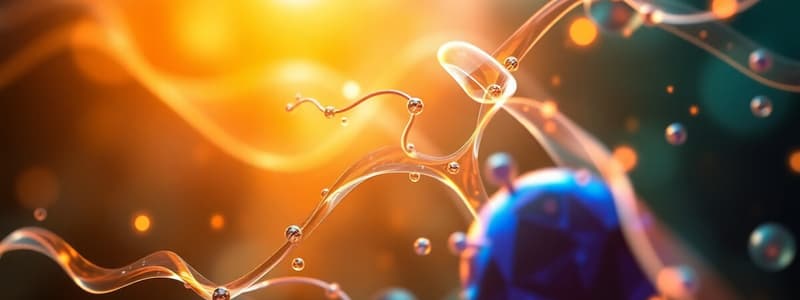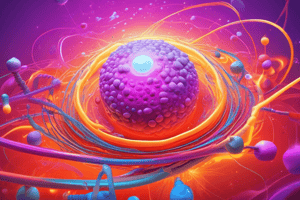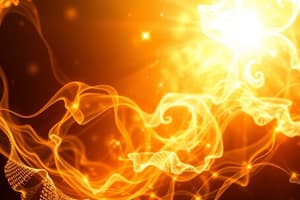Podcast
Questions and Answers
Which of the following statements accurately describes the concept of entropy ($ \Delta S $) in thermodynamics?
Which of the following statements accurately describes the concept of entropy ($ \Delta S $) in thermodynamics?
- It represents the energy available to do work at constant temperature and pressure.
- It indicates the degree of randomness or disorder within a system. (correct)
- It quantifies the heat change during a chemical reaction.
- It measures the total usable energy stored in the bonds of a molecule.
For a reaction to proceed spontaneously, what condition must generally be met regarding the change in Gibbs free energy ($ \Delta G $)?
For a reaction to proceed spontaneously, what condition must generally be met regarding the change in Gibbs free energy ($ \Delta G $)?
- The $ \Delta G $ must be negative, indicating an exergonic reaction. (correct)
- The $ \Delta G $ must be equal to the change in enthalpy ($ \Delta H $).
- The $ \Delta G $ must be positive, indicating an endergonic reaction.
- The $ \Delta G $ must be zero, indicating a reaction at equilibrium.
In the Gibbs free energy equation ($ \Delta G = \Delta H - T\Delta S $), what does $ \Delta H $ represent?
In the Gibbs free energy equation ($ \Delta G = \Delta H - T\Delta S $), what does $ \Delta H $ represent?
- The change in enthalpy, or heat content, of the system. (correct)
- The absolute temperature in Kelvin.
- The change in entropy of the system.
- The amount of usable energy available from a reaction.
Considering water ($H_2O$) in its three states—gas, liquid, and solid—which statement is most accurate regarding enthalpy ($ \Delta H $)?
Considering water ($H_2O$) in its three states—gas, liquid, and solid—which statement is most accurate regarding enthalpy ($ \Delta H $)?
What does it mean for Gibbs free energy ($ \Delta G $) to be a state function?
What does it mean for Gibbs free energy ($ \Delta G $) to be a state function?
If the concentration of the reactants in a reaction is increased, what effect will this have on $ \Delta G $?
If the concentration of the reactants in a reaction is increased, what effect will this have on $ \Delta G $?
Consider the reaction $A \rightarrow B$. If at equilibrium the concentration of B is much greater than the concentration of A, what does this indicate about the equilibrium constant ($K_{eq}$) and $ \Delta G $?
Consider the reaction $A \rightarrow B$. If at equilibrium the concentration of B is much greater than the concentration of A, what does this indicate about the equilibrium constant ($K_{eq}$) and $ \Delta G $?
What is the relationship between $ \Delta G\degree $ and $K_{eq}$?
What is the relationship between $ \Delta G\degree $ and $K_{eq}$?
If a reaction has a positive $ \Delta G\degree $, can it ever be favorable?
If a reaction has a positive $ \Delta G\degree $, can it ever be favorable?
The reaction of glucose to glucose-6-phosphate has a $ \Delta G $'° of +13.8 kJ/mol, while the hydrolysis of ATP to ADP has a $ \Delta G $'° of -30.5 kJ/mol. If these reactions are coupled, what is the overall $ \Delta G $'° for the coupled reaction?
The reaction of glucose to glucose-6-phosphate has a $ \Delta G $'° of +13.8 kJ/mol, while the hydrolysis of ATP to ADP has a $ \Delta G $'° of -30.5 kJ/mol. If these reactions are coupled, what is the overall $ \Delta G $'° for the coupled reaction?
Flashcards
Bioenergetics and Thermodynamics
Bioenergetics and Thermodynamics
The quantitative study of energy transductions in living cells and the chemical processes underlying these transductions.
First Law of Thermodynamics
First Law of Thermodynamics
The total amount of energy in the universe remains constant; energy cannot be created or destroyed, only changed.
Second Law of Thermodynamics
Second Law of Thermodynamics
The universe always tends toward increasing disorder; entropy increases in all natural processes.
Gibbs Free Energy (ΔG)
Gibbs Free Energy (ΔG)
Signup and view all the flashcards
Exergonic Reaction
Exergonic Reaction
Signup and view all the flashcards
Endergonic Reaction
Endergonic Reaction
Signup and view all the flashcards
ΔG° (Standard Free Energy)
ΔG° (Standard Free Energy)
Signup and view all the flashcards
State Function (ΔG)
State Function (ΔG)
Signup and view all the flashcards
Equilibrium
Equilibrium
Signup and view all the flashcards
Effect of Changing Conditions on Equilibria
Effect of Changing Conditions on Equilibria
Signup and view all the flashcards
Study Notes
Principles of Bioenergetics
- Bioenergetics and thermodynamics quantitatively study energy transductions in living cells.
- It explores the nature and function of chemical processes behind these transductions.
- Energy is the ability to do work.
- Chemical reactions are studied from thermodynamics and kinetics perspectives.
- Thermodynamics (bioenergetics) focuses on the energy transformation by analyzing the starting and ending points of reactions.
- Kinetics examines the processes occurring between these points.
- Thermodynamics is the focus.
Laws of Thermodynamics
- The first law (conservation of energy) states the total amount of energy in the universe remains constant for any change noting that energy cannot be created nor destroyed.
- Energy can be changed from one form to another.
- The second law of thermodynamics dictates the universe tends towards increasing disorder.
- Entropy (ΔS) measures how random or disordered a system is, describing how molecules are arranged within a sample.
- Natural systems tend to become more disordered over time, as molecules spread apart.
- Disorder happens spontaneously without needing energy.
- Organizing a system requires energy.
Concept of Free Energy
- Gibbs free energy (ΔG) is the usable energy stored in a molecule's bonds.
- It indicates whether a biochemical reaction will occur spontaneously through energy absorption/release.
- ΔG= ΔH – TΔS, where:
- ΔG is the free energy in the system (negative in spontaneous reactions).
- ΔH is enthalpy (heat change).
- T is temperature.
- ΔS is entropy (randomness/disorder in the system).
- If ΔG is negative, the reaction releases energy and occurs spontaneously (exergonic).
- If ΔG is positive, the reaction requires energy input to proceed (endergonic).
- When water (H2O) exists as gas, liquid, or solid, energy and disorder differ.
- ΔG stays constant because the molecule is still H2O with the same bonds, yet can change regarding temperature and pressure.
- Enthalpy (ΔH) varies andis lowest in solid state (ice), higher in liquid, and highest in gas because of the energy in molecular bonds.
- Entropy (ΔS) measures disorder and is lowest in the solid state (more ordered), higher in liquid, and highest in gas.
- Each state has different ΔH and ΔS, unlike ΔG
- By rearranging the equation to ΔH = ΔG + TΔS, it is inferred that ΔH is the total energy of the system.
- Thermodynamics indicates if a reaction is possible.
Chemical Reactions
- Chemical reactions occur to reach stability with the lowest energy amount.
- Logically, biochemical reactions go from high to lower energy scales.
- Exergonic reactions:
- ΔG is negative.
- They are spontaneous.
- They are favorable.
- Endergonic reactions:
- ΔG is positive.
- They are non-spontaneous.
- They are non-favorable.
- Reactions need added energy to occur, like adding ATP.
Standard ΔG
- ΔGo represents ΔG at standard conditions: 1 atm, 1 M concentrations of reactants/products, 25°C, and pH=7. It compares different reactions in the laboratory
- Altering concentrations will change the ΔG
State Function
- ΔG is a state function, meaning it relies only on the starting and ending points (concentrations) not the reaction mechanism or intermediates.
Glucose
- Combustion of glucose in a calorimeter:
- Glucose + O2 → CO2 + H2O.
- ΔG = -680 kcal/mol.
- Glycolysis and Krebs cycle are complex, multi-step processes that do not affect the overall ΔG.
- Glucose → CO2 + H2O. ΔG = -680 kcal/mol.
- The pathway order does not matter, so ΔG is still the same.
Concentration Impact
- ΔG calculation in the reaction Glucose → Glucose 6-phosphate uses the formula ΔG = Gf - Gi.
- Gf is free energy of final product (glucose 6-phosphate).
- Gi is free energy of initial reactant (glucose).
- Altering glucose concentration changes ΔG because concentration affects molecular number/bonds.
Reaction Spontaneity
- ΔG determines reaction spontaneity.
- Adjusting reactant/product concentrations (e.g., glucose/glucose 6-phosphate) can make the reaction spontaneous (negative ΔG) or non-spontaneous (positive ΔG).
- Changing concentrations influences if reactions occurs naturally or needs energy input
- Equilibrium happens when the energy of reactants equals the energy of products (not concentrations).
Relationship of ΔGo and ΔG
- ΔG = ΔGo + RT ln ([Products]/[Reactants]).
- ΔG = ΔGo + RT 2.3 log ([Products]/[Reactants]).
- Temperature and atmosphere are constant, so concentrations are the only variables.
- When [products] < [reactants], then ΔG < ΔGo.
- When [products] > [reactants], then ΔG > ΔGo.
- When [products] = [reactants], then ΔG = ΔGo.
- Equilibrium occurs at the end.
- At equilibrium concentrations are fixed; rates are equal.
- Concentrations define the equilibrium constant.
- Altering concentrations modifies ΔG.
- It is possible to make a nonspontaneous reaction spontaneous by concentration adjustments.
- Increase reactants or decrease can result a more negative value of ΔG.
Equilibrium Consideration
- At equilibrium, ΔG is zero (ln 1 = 0).
- You can have an unfavourable situation and still make it favorable by manipulating the conditions.
- Non-standard conditions drive the reaction in the required direction.
The End
Studying That Suits You
Use AI to generate personalized quizzes and flashcards to suit your learning preferences.





